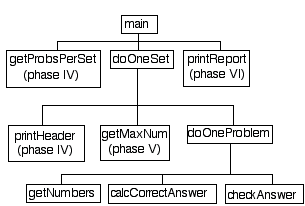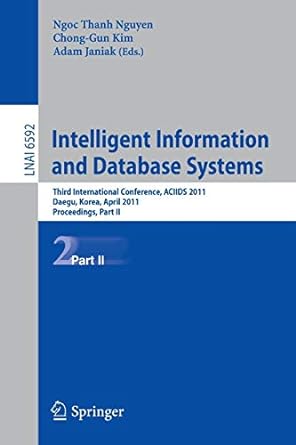Question
Project 2: Math Tutoring This program will ask the user to answer a series of arithmetic problems and report on how the user performs. You
Project 2: Math Tutoring
This program will ask the user to answer a series of arithmetic problems and report on how the user performs. You will write this program in the following phases. Make sure that each phase works correctly and is stylistically perfect before progressing to the following phase.
Note that the purpose of this assignment is to give you lots of practice with parameter passing without making you write a huge program. For this reason I have provided a structure diagram at the end of this document. Make sure that you adhere to the structure diagram carefully and DO NOT use global variables. Turn in only your final product.
Phase I: Your main function for phase I must look exactly like this:
int main() { srand(time(0)); doOneSet(); } |
You must write the function doOneSet which will, for now, write out 5 addition problems. All of the numbers in your programs should be between 0 and 100. Here is the sample output for this phase:
45 + 21 = 0 + 100 = 54 + 23 = 4 + 19 = 8 + 92 = |
The numbers that are produced for these problems must be generated randomly by the computer. The numbers in the sample output are given only as an example. We will discuss in the lessons how to generate random numbers.
Phase II: Change your doOneSet function so that instead of just writing out the problems it also allows the user to enter an answer, and then tells the user whether the answer was correct or not. Do not change your main function. Here is the sample output for this phase (user input is indicated here by using bold font. It won't be bold in your own output):
45 + 21 = 66 correct 0 + 100 = 100 correct 54 + 23 = 67 incorrect 4 + 19 = 13 incorrect 8 + 92 = 100 correct |
Phase III: Now you will change your doOneSet function so that it will work for either addition, subtraction, or multiplication. For the purposes of this assignment, a set of problems is defined to be a group of problems that are all of the same type (all addition, all subtraction, or all multiplication). After completing this phase your program will give 5 addition problems, 5 subtraction problems, and 5 multiplication problems, for a total of 15 problems. Your main function must look exactly like this:
int main() { srand(time(0)); doOneSet('+'); doOneSet('-'); doOneSet('*'); } |
The parameter tells doOneSet whether to do addition, subtraction, or multiplication. Notice that there is exactly one doOneSet function definition, not three! Here is the sample output for this phase:
45 + 21 = 66 correct 0 + 100 = 100 correct 54 + 23 = 67 incorrect 4 + 19 = 13 incorrect 8 + 92 = 100 correct 59 - 19 = 40 correct 19 - 84 = -29 incorrect 0 - 65 = -65 correct 96 - 1 = 95 correct 94 - 14 = 80 correct 0 * 87 = 0 correct 45 * 84 = 398 incorrect 8 * 37 = 873 incorrect 34 * 83 = 831 incorrect 38 * 3 = 238 incorrect |
Note: Do not proceed on from phase III until you are sure your program is perfect and you have checked to make sure that you have adhered to structure diagram given at the end of this document!!!
Phase IV: Now you are ready to let the user specify how many problems per set. However, due to certain new software use guidelines the user is allowed between 3 to 10 problems per set per run of the program. (Recall that a set is a group of problems all of the same type. In this program we are doing three sets: one set of addition, one set of subtraction, and one set of multiplication. This means that, for example, if the problems per set is 7, there will be a total of 21 problems given.) As per the new guidelines, ask the user to enter only the acceptable number of problems per set at the very beginning of the program, so that all three sets have the same number of problems per set. Now your main function will look exactly like this (you may add variable declarations only):
int main() { int probsPerSet; srand(time(0)); getProbsPerSet(probsPerSet); doOneSet('+', probsPerSet); doOneSet('-', probsPerSet); doOneSet('*', probsPerSet); } |
For this phase you should also add a header at the beginning of each set, as illustrated in the following sample output for this phase. For purposes of the header, you should assume that the addition problems will always be set #1, the subtraction problems set #2, and the multiplication problems set #3.
Enter problems per set: 3 Set #1 ---------- 45 + 21 = 66 correct 0 + 100 = 100 correct 54 + 23 = 67 incorrect Set #2 ---------- 59 - 19 = 40 correct 19 - 84 = -29 incorrect 0 - 65 = -65 correct Set #3 ---------- 0 * 87 = 0 correct 45 * 84 = 398 incorrect 8 * 37 = 873 incorrect |
Phase V: Now let the user specify maxNum, the maximum number to be used for each set. This means that instead of choosing numbers between 0 and 100 (inclusive) for each problem, the computer will be choosing numbers between 0 and maxNum (inclusive). You must allow the user to enter a different maximum number for each set. This won't change the main function, since you need to ask it again before each set. It will be done near the beginning of your doOneSet function. Here's the sample screen output:
Enter problems per set: 3 Set #1 ---------- What is the maximum number for this set? 100 45 + 21 = 66 correct 0 + 100 = 100 correct 54 + 23 = 67 incorrect Set #2 ---------- What is the maximum number for this set? 90 59 - 19 = 40 correct 19 - 84 = -29 incorrect 0 - 65 = -65 correct Set #3 ---------- What is the maximum number for this set? 20 0 * 18 = 0 correct 15 * 4 = 398 incorrect 8 * 17 = 873 incorrect |
Phase VI: Now you need to keep track of how the user is doing. At the end of the program, write a report which says how many the user got right on each set out of how many and for what percent. Also tell the overall figures. Here's the sample screen output:
Enter problems per set: 3 Set #1 ---------- What is the maximum number for this set? 100 45 + 21 = 66 correct 0 + 100 = 100 correct 54 + 23 = 67 incorrect Set #2 ---------- What is the maximum number for this set? 90 59 - 19 = 40 correct 19 - 84 = -29 incorrect 0 - 65 = -65 correct Set #3 ---------- What is the maximum number for this set? 20 0 * 18 = 0 correct 15 * 4 = 398 incorrect 8 * 17 = 873 incorrect Set#1: You got 2 correct out of 3 for 67% Set#2: You got 2 correct out of 3 for 67% Set#3: You got 1 correct out of 3 for 33% Overall you got 5 correct out of 9 for 56% |
Your main function for phase VI must look like this (you may add variable declarations and arguments only):
int main() { int probsPerSet; int set1Correct,set2Correct, set3Correct; srand(time(0)); getProbsPerSet( |
Please note that you may send no more than 3 arguments to doOneSet. Hint: Although main will need three separate variables to keep track of the number of problems answered correctly in each set, your doOneSet function will have only one parameter which keeps track of the number of problems answered correctly in the current set. It will be up to main to get that information into the correct variable.
The following structure diagram includes every function that you will have in your program. You should have no more and no fewer, and you should use the names that have been suggested here. Functions pictured below that are not labeled with a phase should be implemented at least by phase III. Please also read the notes below the structure diagram very carefully.

This is what my professor stated about the program below. Could you possibly help me finish it?
5 points per correct function name/procedure used (see structure diagram ) - 4 functions *5. Missing 6 functions as per project specifications.
Meets function documenation requirements in part. Missing data flow comments in all function prototype and function heading parameter lists as well as pre/post conditions in function definitions and function descriptions
Except for missing over all correct value and percentage, all other set values displayed are correct.
#include
#include
#include
#include
using namespace std;
void getProbsPerSet(int&);
void doOneSet(char,int,int&);
void printReport(int,int,int,int);
int main()
{
int probsPerSet,correctAdd=0,correctSub=0,correctMult=0;
srand(time(0));
getProbsPerSet(probsPerSet);
doOneSet('+', probsPerSet,correctAdd);
doOneSet('-', probsPerSet,correctSub);
doOneSet('*', probsPerSet,correctMult);
printReport(probsPerSet,correctAdd,correctSub,correctMult);
system("pause");
}
void getProbsPerSet(int& probsPerSet)
{
cout
cin>>probsPerSet;
}
void doOneSet(char op,int n,int& correct)
{
int i,max,set,ans,user,op1,op2;
switch(op)
{
{
case '+': set=1; break;
case '-': set=2; break;
case '*': set=3; break;
}
}
cout
cout
cin>>max;
for(i=0;i { op1=rand()%(max+1); op2=rand()%(max+1); switch(op) { case '+': ans=op1+op2; break; case '-': ans=op1-op2; break; default: ans=op1*op2; } cout cin>>user; if(ans==user) { cout correct++; } else { cout } } } void printReport(int set,int add,int sub,int mult) { cout cout cout }
Step by Step Solution
There are 3 Steps involved in it
Step: 1

Get Instant Access to Expert-Tailored Solutions
See step-by-step solutions with expert insights and AI powered tools for academic success
Step: 2

Step: 3

Ace Your Homework with AI
Get the answers you need in no time with our AI-driven, step-by-step assistance
Get Started


